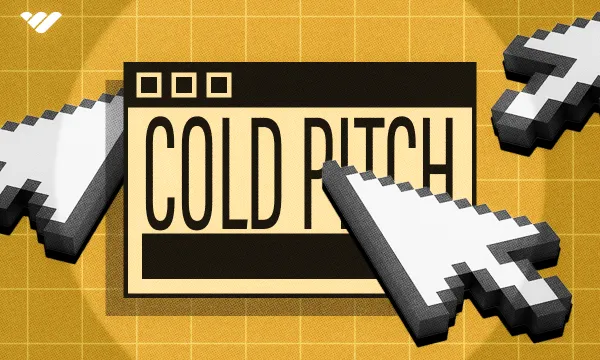You're a talented freelancer or content creator with impressive skills, but you're stuck competing for scraps on crowded platforms. Frustrating, right? Most people haven’t had as much success with cold emailing for two reasons: They suck at writing cold emails, or they don’t have respond-worthy content.
Here's the game-changer you've been looking for: The art of cold pitching. And no, I'm not talking about those cringe-worthy "Dear Sir/Madam" emails that flood your spam folder.
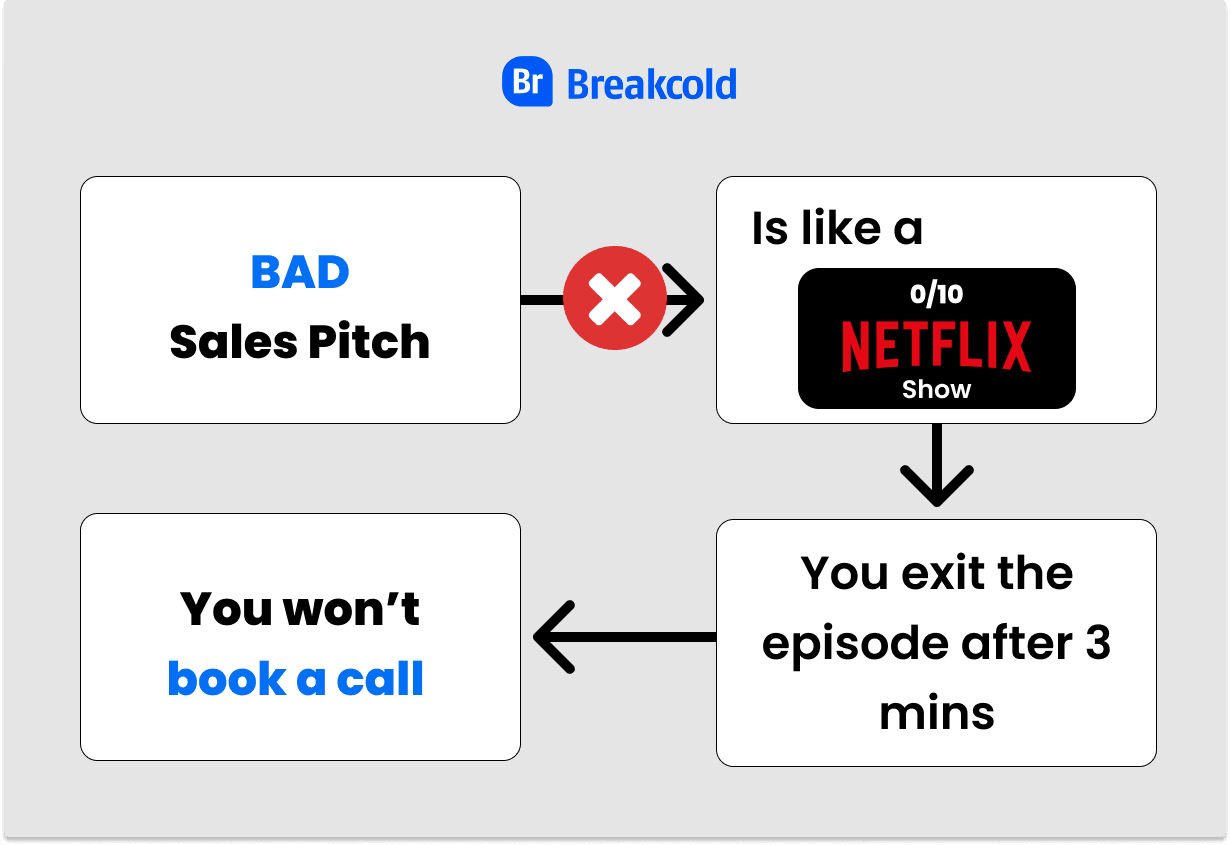
Take Colleen Welsch, a freelance writer who, after being laid off in one of the most expensive cities in the world (LA), found herself writing work with the trusty cold pitch. She collected the names of every beauty company she could find, put them in a spreadsheet, and noted whether they had an updated blog.
“If they had a blog that hadn’t been updated in a while, I sent them my cold email pitch. Most of the time I received no response, but every once in a while I DID get a client! And by continually reaching out, I was able to eventually book enough work to make a living as a freelance writer. Using this method earned me over $4,500 in my first three months of writing.” says Colleen.
Now, I know what you're thinking—cold pitching is pushy, or worse, it never works. But here's the truth: Decision-makers are constantly looking for talented professionals who can solve their problems.
I’ve been where you are. That’s why, I’m taking everything I’ve learned to show you how to cold pitch like a pro. With battle-tested templates and strategies, you’ll soon be turning cold leads into cold, hard cash.
The psychology of effective cold pitching
Let's talk about what's really going on in your prospect's mind when they see a cold pitch.
Most decision-makers aren't sitting around waiting for your email or call. They're juggling multiple priorities, their phone's constantly buzzing, and their inbox is overflowing. Their coping mechanism? A kind of mental shortcut system to sort incoming information into "relevant" and "not relevant" piles. You've got precious little time—often just seconds—to land on the right side of that divide.
Also, remember, they don’t know that they NEED your services. At least not yet. They're probably quite comfortable with whatever solution they're currently using. It's human nature to stick with what's familiar, even if it's not perfect.
So your first challenge isn't just presenting your solution; it's helping them recognize there might be a better way without making them feel like they've been making a mistake.
Instead of “Your current spreadsheet system is inefficient and causing you to waste hours every week,” your approach should be “Many businesses we work with were surprised to discover they could free up 5-7 hours every week just by automating their recurring tasks.”
Here are three psychological principles for connecting with potential clients
Show you've done your homework
When you show that you truly understand their business, you trigger something interesting in human psychology: People naturally want to respond in kind to thoughtful gestures. This can help break down the automatic skepticism most people have toward cold outreach.
Here’s an example: "I noticed your sourdough loaves and custom birthday cakes get amazing reviews on Google, but your Instagram hasn't captured those happy customer moments yet. Last week, I saw you launched that new seasonal pumpkin spice croissant line—those look incredible! For specialty bakeries like yours, there's often a big opportunity to turn those limited-time offerings into social media events that bring in new customers."
Timing is everything
The "when" of your pitch matters just as much as the "what." Catch someone during their annual planning phase, and they're much more likely to be receptive. Conversely, if you reach out while they're racing to meet a deadline, you'll likely be ignored. It's like trying to have a serious conversation with someone running to catch a train.
Personalization beats volume
Personalized outreach is nearly 50% more likely to get a response. Think about your own reaction when you receive an obviously generic message versus one that shows a genuine understanding of your situation. The difference in how we process and respond to these messages is dramatic.
How to cold pitch as a freelancer or content creator
Cold pitching doesn't have to feel cold. Here’s what you need to know to connect authentically with prospects, demonstrate your unique value, and turn strangers into clients.
Define your ideal client profile
Before crafting your pitch, you need a crystal-clear picture of who you're targeting. Your ideal customer is defined by their problems and goals, not just their basic traits.
Research their industry, company size, revenue, and decision-making structure. What keeps them up at night? What solutions have they tried before? Study their social media, website, and press releases to grasp their company culture and values.
The more specific your ICP, the better you can tailor your pitch to resonate with their needs.
Research your prospective client
Start with a comprehensive LinkedIn review to understand your prospect. What's their content style? How do they engage with their audience? What have they been up to lately? It's like doing homework, but way more interesting.
Find out which social channels they're most active on and spend some time there. It's not just about following them—it's about understanding their voice and what matters to them. Set up Google News alerts to stay in the loop about their latest wins and developments.
- What is a target persona and how do you create one?
- Customer behavior analysis: What is it, how do you conduct it, and why should you do it?
Identify prospects
Start building a focused list of 20-30 prospects who feel like a natural fit for your style and expertise. While you're mapping this out, make a note of both decision-makers and their team members—sometimes, that content manager has more say than you'd think!
Need to find their email? Tools like Hunter.io offer free options for creators and freelancers like you. In the worst-case scenario, simply guess their email — at small companies, it's usually just the founder's first name and company domain. At mid-sized companies, firstname.lastname@companydomain.com works well too.
Craft your pitch
You know that moment when you're staring at a blank email, trying to reach that perfect client? That’s what crafting your pitch can feel like when you’re directionless. Here's the thing: You don't need gimmicks—you need strategy.
A cracker subject line
Think of your subject line as a handshake. Make it firm, professional, but interesting. Something like, "Your content strategy caught my eye, [Name]," works because it's personal without being pushy. Those generic "Freelancer available" emails? They're gathering dust in spam folders.
The opener
They’ve opened your email. Now what? Skip the small talk and show you've done your homework. "I was reading your latest piece about AI implementation, and your point about ethical guidelines really resonated..."
Don’t be afraid to get a little personal. If you’ve been following the prospect for a while, you probably know a little about them. Let it show in your opener. “Saw you went to school in Negev and curious to know how you survived (haha)—it was blazing hot when I spent time there.” Now you've got their attention because you're talking about them, not just yourself.
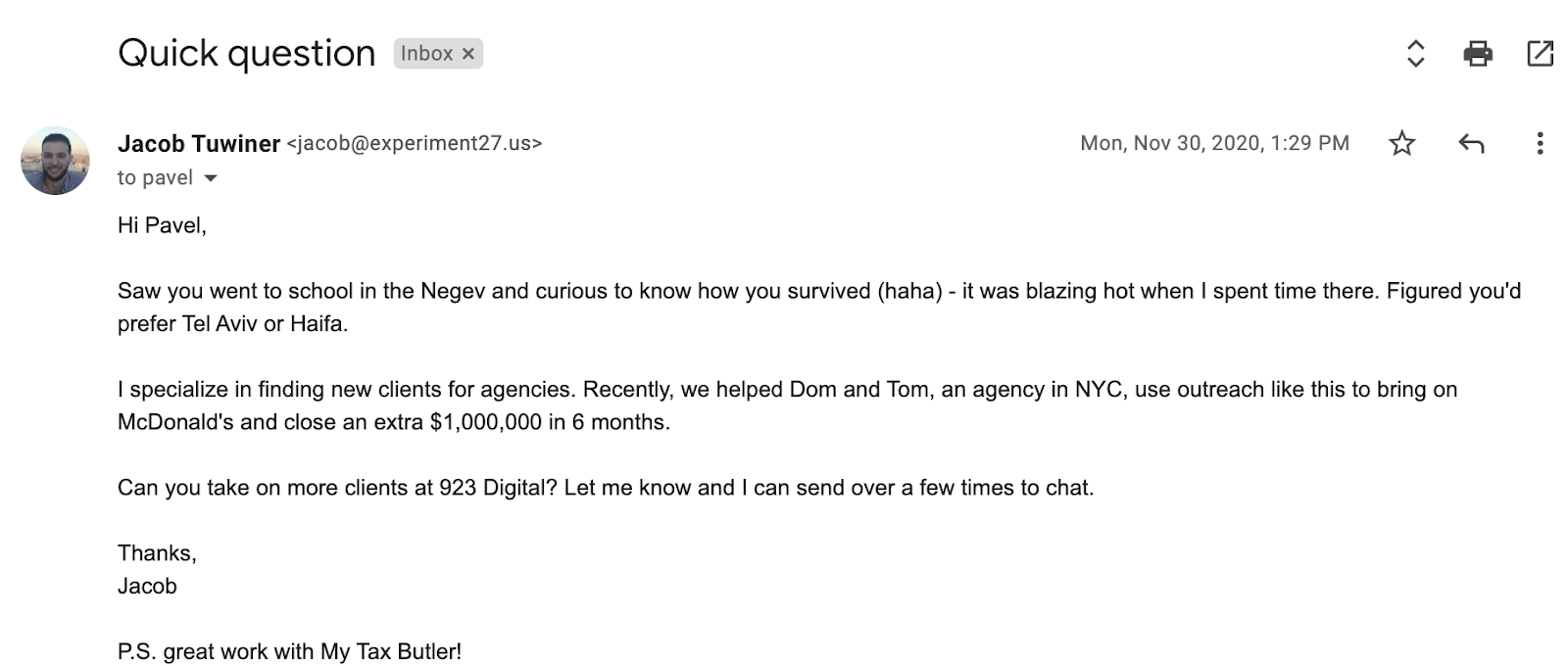
Your value proposition
Tell a story. Don't just say you're a content writer—explain how you've helped companies like theirs solve real problems. "I recently helped a fintech startup boost their blog traffic by 60% by restructuring their content strategy."
Sprinkle in your credentials naturally, as if you're sharing relevant experience with a colleague. Drop names only when they matter to your prospect's industry. A recent Reddit thread revealed some interesting responses to the question, "Founders, what’s the best cold DM/email you’ve ever gotten that actually led to a deal?" Paul Howey shared an email that “works every time as long as I need what you are selling.”
The email template (see pic below) is straightforward and professional and describes the value you offer (and how) in a few crisp sentences. It also offers two calls to action for the prospect to choose from (depending on their interest level)—"Book a demo" or "Start a free trial."
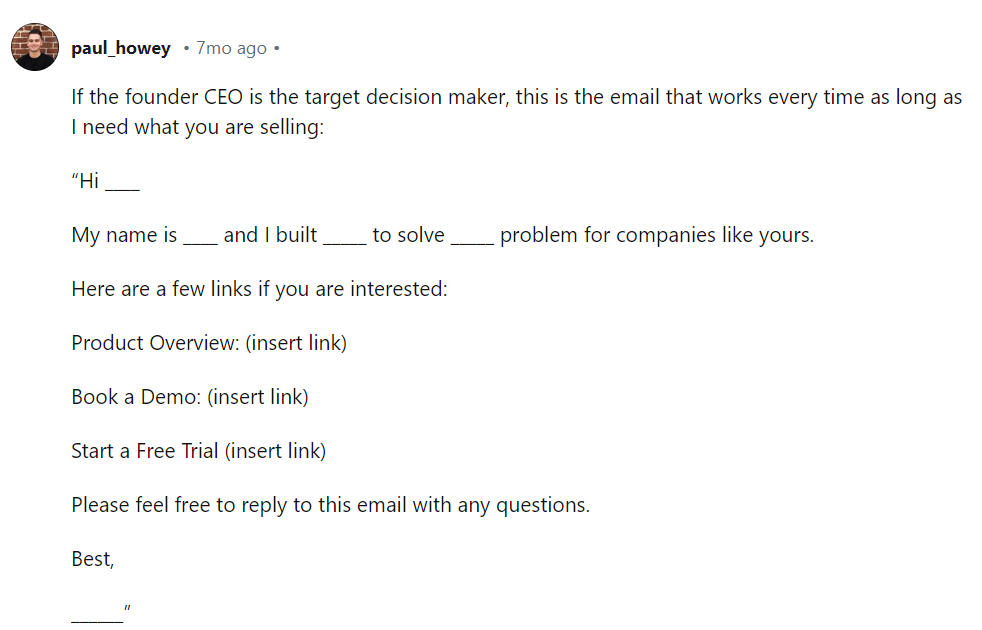
Personalize
You’re trying to personalize the email? Great thinking. Here’s a tip: Dig deeper than their website's homepage. Maybe they just launched a new product, or their CEO shared an interesting perspective on LinkedIn. Show that you're genuinely plugged into their world.
The call to action
Don’t miss this. Without a call to action, your prospect won't know what you expect from them. A crappy one? You risk confusing or worse, annoying them.
End with something simple and specific: "Could I walk you through some content ideas over a quick call this week?", "Care for a guest post?" or even something that starts a conversation like "Are you happy with your team’s [specific output]?" or "Open to seeing how it works?"
Follow up
Send that first follow-up too quickly and you might come across as anxious. Wait too long and your prospect has likely forgotten about your brilliant proposal. What’s the sweet spot? Ideally, you'll want to wait at least 3-5 business days after your initial pitch before checking in.
Think of your follow-up strategy as a carefully planned conversation. Instead of just popping in to say, "Hey, did you get my email?" (we've all been guilty of this), make each contact meaningful. Your second message might highlight an interesting industry trend you've noticed, while your third could showcase how you helped a similar business solve a specific challenge.
Read the room with each prospect. Notice they've read your DM but haven’t responded? They're probably interested but have some hesitations. Or, they need to talk about it to someone else. Address these potential concerns head-on. Getting radio silence? Consider switching things up with a different approach or reaching out on another platform instead.
Email marketer Francis Nayan sums it up in this tweet, adding, “It’s impossible to NOT land a client” with his strategy.
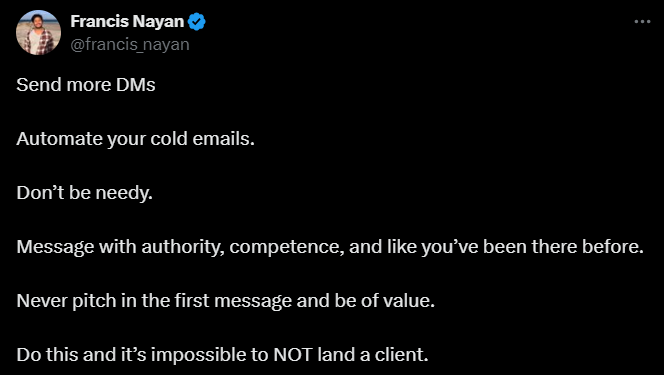
Here's the tricky part: Knowing when to keep going versus when to bow out gracefully. Keep the conversation going if you see positive signals—email opens, LinkedIn profile views, or even brief responses.
But if you've reached out 3-4 times over three weeks with complete silence, it's time to move on. Send a friendly "break-up" email leaving the door open for future opportunities, then redirect your energy toward promising new prospects. After all, today's "not now" could become tomorrow's "yes."
How to build a sustainable pitching system
Now that you've learned how to craft a cold pitch, you have to keep doing it again and again. The key to success isn't just in writing one perfect pitch—it's in building a sustainable system that lets you consistently reach out to prospects without burning out.
Create a daily or weekly pitching routine
The secret to a successful pitching strategy isn't in occasional bursts of inspiration—it's in the quiet consistency of showing up every day. Carve out a sacred block of time in your day for your outreach efforts.
While templates can streamline your process, remember that each pitch needs your personal touch. Many successful freelancers find that batching similar tasks works wonders—spend one session researching multiple prospects, then dedicate the next to writing their pitches.
Set realistic goals
Focus on tracking meaningful data points. You don’t need fancy software to do this—a simple Google sheet can do the job. How many qualified prospects are you identifying? What is your pitch response rate? How many turn into actual conversations, and ultimately, signed clients?
Start modest—you'd be surprised how much more effective a handful of carefully crafted pitches can be compared to dozens of rushed ones. Pay attention to what's working and adjust your targets accordingly.
Manage and track your pipeline
Think of your pipeline as a garden that needs regular tending. Keep notes on each prospect, when you last reached out, and what's next in your follow-up sequence. Create a clear schedule for follow-ups—being persistent without being pushy is an art form.
Your system should tell you at a glance where each prospect stands and what needs your attention next. Mid-sized and large businesses use CRM software to manage their pipeline. But, as an individual with limited prospect outreach, all you need is a neat and organized spreadsheet.
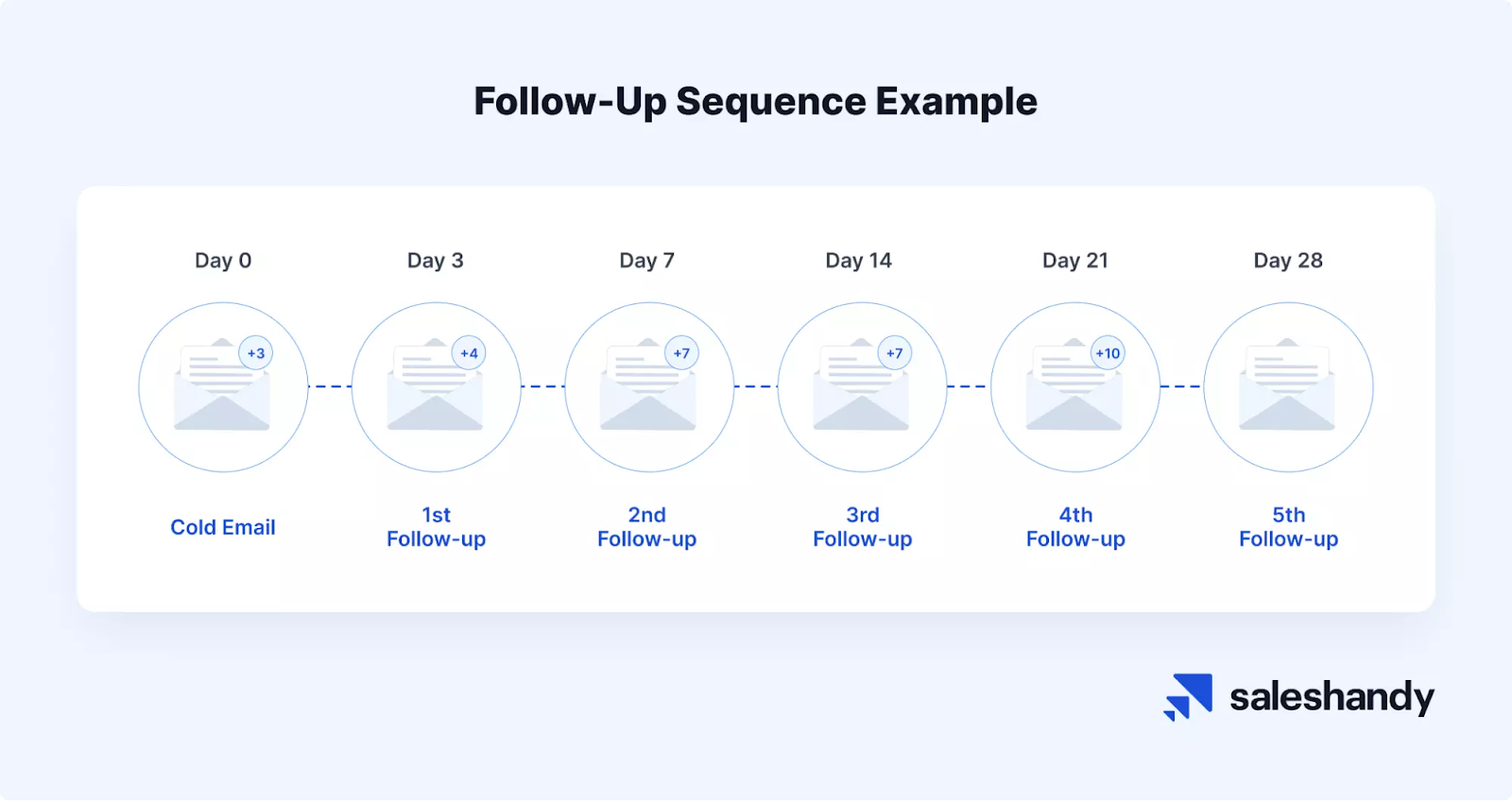
How to convert prospects to high-paying clients
Let's talk about something every freelancer dreams of: Turning cold prospects into clients who actually value your work and pay you what you're worth.
1. Move from initial interest to sales call
To get that first sales call, you need to play it smart. Rather than jumping straight into "hire me!" mode, start by showing you've done your homework. Spot a challenge their business is facing? Lead with that.
When you notice they've checked out your profile or responded to your message, strike while the iron's hot—follow up within 24 hours. A simple "Hey, I noticed you're dealing with [specific challenge]. Would you be open to a quick 15-minute chat about how I helped [similar company] tackle this?" works wonders.
2. Leverage LinkedIn and social proof
Think of your LinkedIn profile as your digital storefront—it needs to do the selling for you. Don't just list your services; show off your wins where everyone can see them. Share stories about client successes, jump into meaningful conversations in your industry, and be genuinely helpful. When you're consistently showing up and sharing valuable insights, prospects start seeing you as the expert you are, not just another freelancer in their inbox.
3. Use case studies effectively
Case studies are your best friends when it comes to landing premium clients. But here's the secret: Tell a story your prospect actually wants to read. Break it down into three simple parts: The problem your client faced, how you swooped in to help, and the concrete results you delivered. Keep it punchy, focus on numbers that make executives sit up and take notice, and always include a glowing testimonial that backs up your claims.
4. Negotiate for premium rates
Let's get real about money. Stop thinking of yourself as an expense on a spreadsheet and start positioning yourself as an investment in your prospect's success. When talking numbers, lead with value—what they'll gain, not what they'll spend.
Give them options (think good, better, best), but make sure your preferred package sits right in the middle. And remember: It's okay to walk away if they're not willing to invest in quality work.
Red flags to watch for in prospects
Here's something worth remembering: Learning to say "no" to the wrong clients is just as important as landing the right ones. Let's talk about those warning signs you shouldn't ignore:
- They can't stop talking about price but never mention value
- There's no clear decision-maker (or worse, too many of them)
- They're weirdly secretive about basic project details
- They want champagne results on a beer budget
- They take forever to respond during the initial conversations
The clients you want will value your expertise, communicate clearly, and understand that quality work is an investment.
Pitches that worked: 2 prime examples
Tired of pitch advice from people who've never sealed a deal? Here's the good stuff—real pitches that made real money.
This cold pitch earned Deya a few 1,000 dollars
In pitch #1 on her YouTube video, Deya explains how a cold DM converted into a client. She started her conversation by complimenting her prospect on a presentation—she even dropped the phrase, “You are a rainbow fish,” a term that she learned from the presentation, which showed that she’d actually read it.
But, she didn’t stop there. She added a cute little GIF with a note, “Because I know you like GIFs.” Too casual for a pitch to a complete stranger, you think? Not for this prospect. By keeping the message super personal and conversational, she matched her prospect’s brand voice. “She had a lot of humor-based components within her branding, which is why I tried so hard to be funny,” explained Deya.
A couple of messages in, Deya transitioned into a mini-pitch introducing herself as a product and content manager for online entrepreneurs. Before she knew it, she was on a call with her prospect, which converted into a project worth a couple of thousand dollars.
Starting out by fangirling is by no means the ideal strategy for cold-pitching. But, in this instance, it was genuine and truly matched the casual vibe of her prospect. The lesson? No two cold pitches are equal. So follow the basics but fine-tune your strategy to hit the bulls-eye.
Cold Email Wizard
In this tweet, Cold Email Wizard breaks down how his cold email approach converted a cold prospect into a warm lead. First, the subject line “Quick question.” Everyone uses it, but for good reason—it works.
The email's first sentence is so individually personalized that you couldn't send it to anybody else. This is what the prospect sees as the preview text in their inbox. So they click it. The function of the subject line and preview text is to get them to OPEN.
The body is a statement, leading to a CTA, "I enjoy connecting with startup founders --> SO let's see if we can support each other." Finally, there are zero links, which increases deliverability and makes it seem softer rather than a sales email.
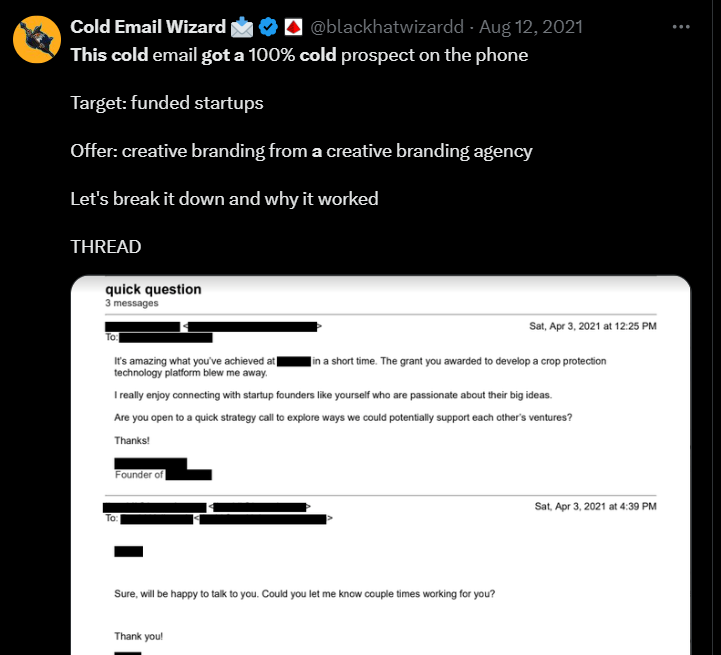
Ready to start cold pitching?
The secret to successful cold pitching isn't about clever tactics or persistence alone. It's about understanding how people think and make decisions, then shaping your approach to work with these natural patterns rather than against them.
Converting prospects into high-paying clients isn't about quick wins or pushy sales tactics. It's about building genuine connections, consistently demonstrating your value, and having the confidence to stand by your worth. And a final important one—learning from rejection. Keep at it, stay professional but human, and watch as those premium clients start coming your way.
Sell your services on Whop
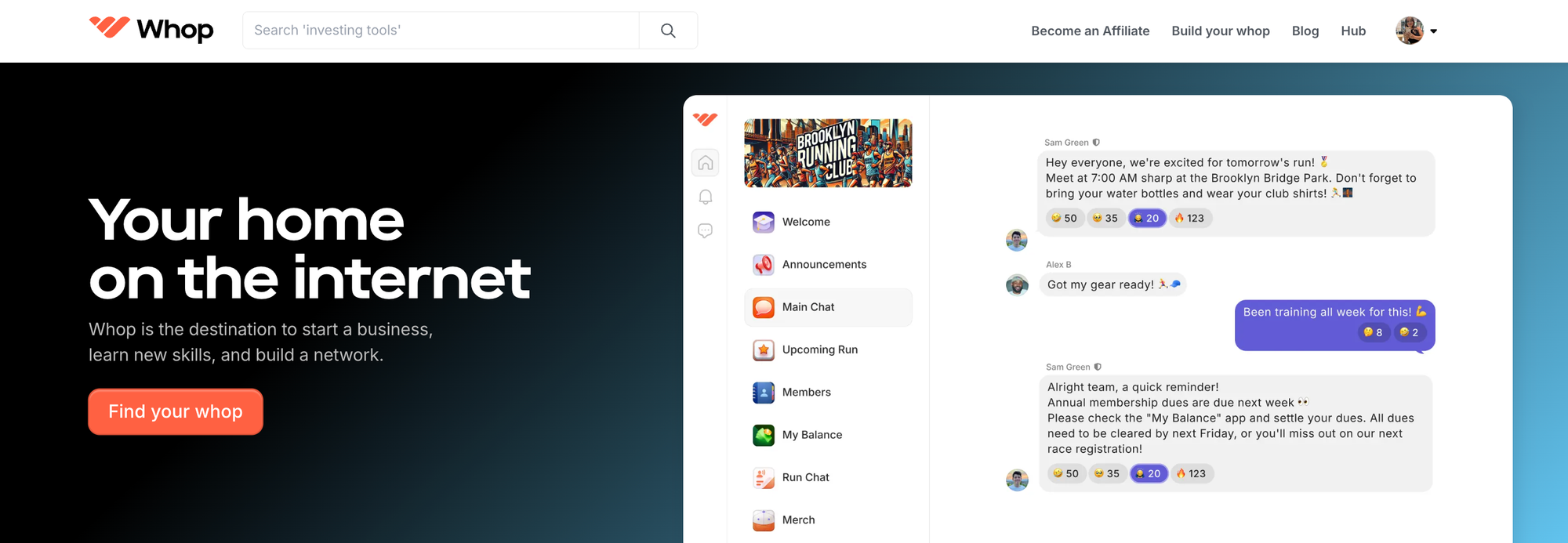
Cold pitching is one way to get into business as a freelancer or content creator. But we all know you can’t rely on one revenue stream alone. As you start gaining some traction and visibility, consider selling your services on Whop.
Anyone can easily launch the business of their dreams with Whop. The user-friendly all-in-one platform allows you to sell courses, exclusive community access, software, ebooks, and other digital products. The possibilities are endless.
Cold pitching FAQs
We’ve answered the most frequently asked questions about cold pitching on the internet, right here.
What is a cold pitch?
When you reach out to someone for business when they've never heard of you before, that’s a cold pitch. It's like introducing yourself to a potential client or investor without anyone making the connection first. While it takes more finesse than reaching out to existing contacts, many professionals still use cold pitching to open new doors and create opportunities.
Is cold pitching effective?
Cold pitching can be effective when done strategically. Success rates are typically low (1-3%), but it can yield valuable connections and opportunities. The key is to personalize your message, target the right prospects, and offer clear value. Quality research and follow-up improve response rates significantly.
How to cold DM on LinkedIn?
Connect with a personalized note referencing your prospect’s recent post, achievement, or shared interest. Keep your message brief, authentic, and focused on their needs. End with a specific question or a soft call-to-action, not a sales pitch. Never ask for a job or meeting immediately.
What are some tips for cold emails that get responses?
Write attention-grabbing subject lines that mention a specific pain point or opportunity. Keep emails short, personalized, and focused on their business challenges. Always research thoroughly and show you've done your homework. End with one clear, easy-to-answer question that sparks curiosity.
Where can I find B2B cold DM templates?
You can find cold email leadgen products on Whop. You can also find free templates on LinkedIn from B2B marketers who share content regularly. Twitter's #b2bmarketing and #freelance communities often post templates too. Just adapt them to sound more personal.
